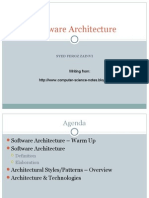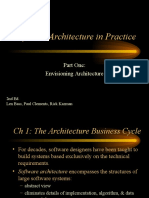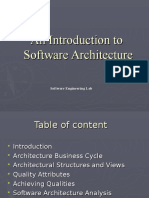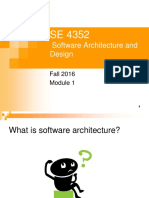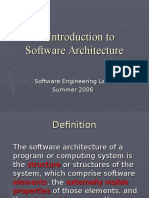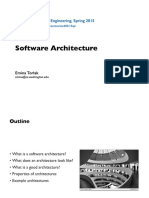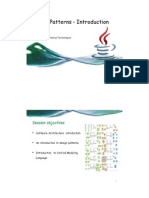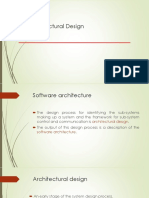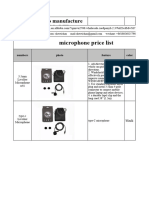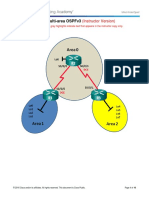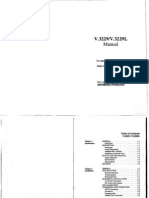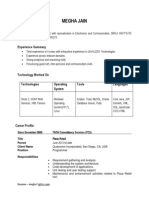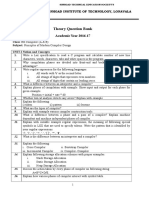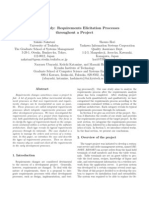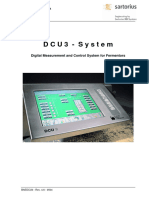UML
Architecture Diagrams
Yvonne Dittrich
IT-University in Copenhagen
Software Development Group
© Dittrich February 06 1
Roadmap
• what is a software architecture
• which diagrams do we have for describing it
• example:
the tools and materials architecture
• architectural patterns and design
© Dittrich February 06 2
© Dittrich February 06 3
� Software architecture
• Designing the global organisation of a
software system
• Dividing software into subsystems
– Deciding how these will interact
– Determining their interfaces
© Dittrich February 06 4
Why develop an architectural model
• To enable everyone to better understand the
system
• To allow people to work on individual pieces
of the system in isolation
• To prepare for extension of the system
• To facilitate reuse and reusability
© Dittrich February 06 5
What to model
• Different views of the system
– Logical breakdown
– Dynamics of interaction among components at
runtime (topic of the next lectures)
– Data shared among subsystems
– The components that will exist at runtime, and the
machines and devices on which they are located
© Dittrich February 06 6
� Challenges
• Producing a relevant picture of a large and
complex system
• It should be easy to understand (even by
clients) by looking at different views and how
these relate to each other
• The architecture model should be stable,
allowing new features to be added with only
minor changes to the overall model
© Dittrich February 06 7
Architectural patterns
• Multi-Layer
• Client-Server
• Broker
• Transaction processing
• Pipe-and-Filter
• Model-View-Controller
• Service-Oriented
• Message-Oriented
© Dittrich February 06 8
How to develop an architectural model?
1. Sketch outline
• Domain model and use cases
• Main components
• Architectural patterns
2. Identify interaction between components
• Decide how data and functionality will be distributed
among components
• Consider reusing existing frameworks
3. Finalize the interfaces of each component
4. Define final class diagrams and interaction
diagrams
© Dittrich February 06 9
� Describing an architecture using UML
• All UML diagrams can be useful, but here we
will cover
– Package diagrams
– Component diagrams
– Deployment diagrams
© Dittrich February 06 10
Package diagrams
• When designing packages, use the principles
of cohesion and coupling
– The content can be reused together
– Minimize the number of dependencies
• Dependencies are shown with dashed arrows
• It is dependencies between elements of
different packages
• A change made to the interface of a package
will require modification to packages that
depend upon it
© Dittrich February 06 11
a good design …
… has no major weaknesses.
… represents a trade-off between different
criteria.
… is (at least) usable, flexible and
understandable.
© Dittrich February 06 12
� layers or (abstract machines)
interface
logic
database
© Dittrich February 06 13
generic architecture pattern
interface
user interface system interface
function
model
technical platform
ui-system database sys. network
© Dittrich February 06 14
client server architecture pattern
Client 1
Client 2 … Client 3
Server
© Dittrich February 06 15
� thick clients - thin clients
Client
interface
function Server
model
Oracle DBMS
© Dittrich February 06 16
thick clients - thin clients
Server
Client
interface function
model
Oracle DBMS
© Dittrich February 06 17
Deployment diagrams
• Show the physical layout of the system
– Where the artifacts (files) physically reside
– Sometimes the files are grouped together in components
– They can be represented in a class notation, with additional
comments
• The artifacts are located at nodes
– Devices or execution environments
• The nodes are connected with communication paths
© Dittrich February 06 18
� Component diagrams
• Whereas package diagrams show the logical
grouping of design elements, component diagrams
show the physical grouping
• What is a component?
– Something that can be sold and upgraded independently
– Provides an interface to other components
• Relationships between components:
– A component may execute another component, or a method
in the other component
– A component may generate another component
– Two components may communicate with each other using a
network
© Dittrich February 06 19
the Tools & Materials Approach
© Züllighoven et al, http://www.jwam.de
combines
• use oriented development
• iterative process model
• a set of related analysis and design
metaphors that anchor the design to the work
practice of the future users
• an architectural style
• design patterns
© Dittrich February 06 20
the metaphor
• materials ‘lie around’ and are used for specific tasks:
paper, folder, schedule, mails, kayaks, courses
• materials are only accessible through the tools manipulating
them
• materials are often organised in specific containers
• tools are used on materials to perform tasks:
pens, punch, editor, browser, viewer
• tools are passive: the hammer does not jump on you
• tools might be specialised, but can also be generic
• one might need automatons as well:
printer, compiler
© Dittrich February 06 21
� How does that relate to the pattern
architecture
• materials can be seen as partitions of the model component,
that is meaningful from a use pov
• tools are partitions in the view and function component. A tool
component consists of a functional part and an interaction part
and so connects a partition I the view and a partition in the
function part
• a tool is a meaningfully related set of functions and related
interface elements
• the overall program is designed as an environment where tools,
materials and automatons ‘lie around’
© Dittrich February 06 22
interface
mat 1 mat 2 printer
browser editor
function
model
material 1 material 2
technical platform
© Dittrich February 06 23
what do we gain?
• tools & materials allow for a modeling that is close to
the use context
• it introduces a way of partitioning the model
component and the interface/function component
• the partitions on the both layers are independent of
each other.
• and architecture that provides a frame for highly
incremental development
• as an architectural style, one can use design and
programming patterns for the connections of the
different elements.
© Dittrich February 06 24
� the pattern template used in the
following slides
• its name: describing the problem and the solution in
1-2 words
• the problem: describing when to apply the pattern
• the solution: the elements of the design, their
relationships, responsibilities, and collaborations
• the consequences: the result and trade-offs of
applying the pattern
© E. Gamma et al.
© Dittrich February 06 25
patterns in the Tools&Materials design
• I only can present part of the design patterns
• the ones I selected should show
– why to use patterns
– how to reason about patterns
• we take the ones
– coupling tools and materials
– division of tools in interaction and functional parts and how they
interact
– composite tools
– the event handler of the environment
© Dittrich February 06 26
Coupling tools and materials
- the problem
• tools and materials have to fit together
• tools might work on different materials - e.g. a
lister would work on different containers
• a material might be accessed and updated by
different tools
© Dittrich February 06 27
� coupling tools and materials
- the first solution
lister
• design an abstract class, an
aspect, that represents the
interface a tool needs and a listable
material has to implement. GiveList
MarkItem
• the materials inherit the aspect GiveMarkedItem
class and implement the GiveListName
abstract methods
• the tool only has to know about books
the aspect, not about the
material
© Dittrich February 06 28
coupling of tools and materials
- consequences of solution 1
+ the compiler can check that the interface is correctly
implemented
+ information hiding: the tool only knows aout the aspect
+ the aspect classes can be used to specify the interface for
parallel development
- uncommon usage of inheritance
- that might make the design difficult to understand
- what if you do not have multiple inheritance?
© Dittrich February 06 29
coupling of tools and materials
- solution 2
• implement the adapter pattern (Gamma et al.)
target adaptee
client
request spec.request ()
adapter
request ()
© Dittrich February 06 30
� listable books
lister
GiveList ListKayaks ()
listable_books
GiveList ()
© Dittrich February 06 31
coupling of tools and materials
- consequences of solution 2
+ aspects are clearly visible in the design
+ you can use that pattern also when the
interfaces are not exactly matching
+ the designer can distinguish between
professionally motivated operations on the
material and the interface for specific tools
- an additional class for each tool-material pair
- the identity problem
- who is creating the adapter object and when
© Dittrich February 06 32
coupling of tools and materials
- solution 3
lister
if you have the possibility to
define an interface in a
listable
programming language this
GiveList
can be used to implement MarkItem
aspects GiveMarkedItem
GiveListName
(interfaces in Java and C#)
books
© Dittrich February 06 33
� coupling of tools and materials
- consequences of solution 3
+ aspects are clearly visible in the design
+ the compiler can check that the interface is
correctly implemented
+ information hiding: the tool only knows about
the aspect
+ the aspect interfaces can be used to specify
the interface for parallel development
- you need a special language construct
© Dittrich February 06 34
interaction between interaction part and
function part of a tool
- the problem
• you want to split the interaction part and the
function part of a tool, to be able to implement
and change them independently
• the interaction part knows the function part
but should not make assumptions about the
result of operations
• the function part should definitely not make
assumptions about what is displayed or how
© Dittrich February 06 35
interaction between interaction part and
function part of a tool
- solution 1
implement he observer pattern between
interaction and function part of a tool
© Dittrich February 06 36
� subject observer
observers
attach (observer) Update ()
detach (observer)
notify () for all o in observers {
o->Update()}
FPLister
subject
IPLister
marked_changed
get_marked Update()
list_changed
get_list_descr
fp FPLister
if (fp->marked_changed){… fp->get_marked …}
if (fp->list_changed){… fp->get_list …}
© Dittrich February 06 37
interaction between interaction part and
function part of a tool
- consequences of solution 1
+ the interaction part knows the function part, but the function
part does not know about the interaction part
+ the interaction part does not make any assumptions about
the result of the method of a function part
- if the request for information changes the state of a
material you might get into a loop.
you can handle that by implementing reading methods
without side effects
- for complex tools the observer pattern might lead to
runtime difficulties.
you can expand the update-method with a parameter,
indicating the type of change that occurred
© Dittrich February 06 38
interaction between interaction part and
function part of a tool
- solution 2
Implement an event handler:
– design a class ‘event’
– the function part creates a specific event-object for each relevant
change
– the interaction part registers at the event-object that are relevant for
it and hands over a method to be called for updating
– the event object keeps a list of all objects registered
– the function part announces a change to the respective event-
object
– the event-object calls the methods that they handed over.
© Dittrich February 06 39
� interaction between interaction part and
function part of a tool
- consequences of solution 2
+ differentiated notification of the objects that
have to be informed about an event
+ the possible changes a function part can
announce are visible in the event-object it
creates
- there is the danger that the function parts get
designed for specific interaction parts. this is
actually the problem, we wanted to avoid…
© Dittrich February 06 40
what more about tools and materials
• combination of tools
– how to manage the communication between different tools
• different tools might change the same material
• administration of materials, especially when accessing a
database server that is used by more than one of such tools &
materials clients
• containers is an own chapter
• framework support
© Dittrich February 06 41
limitations of tools & materials
• complex dependencies between materials?
where to handle them?
• what when the world outside the workshop
gets involved?
• sometimes media metaphors might be better
suited…
© Dittrich February 06 42
� References (besides the course book
• L. Mathiassen et al. Object Oriented Analysis & Design. Marko Publishing ApS, Aalborg,
Denmark 2000.
• D. Garlan, M. Shaw ‘An Introduction to Software Architecture’ in: V. Ambriola, D. Tortoga:
Advances in Software Engineering and Knowledge Engineering, Volume1, New Jersey,
1993.
• H. Züllighonen et al. Object-Oriented Construction Handbook. D-Punkt Verlag, October
2004
• D. Riehle, H. Züllighoven ‘A Pattern Language for Tool Construction and Integration Based
on the Tools&Materials Metaphor.’ Proceedings of the PLOP '94, Monticello, Illinois, August
4-6, 1994.
• E. Gamma et al. Design Patterns. Addison-Wesley 1995.
© Dittrich February 06 43





